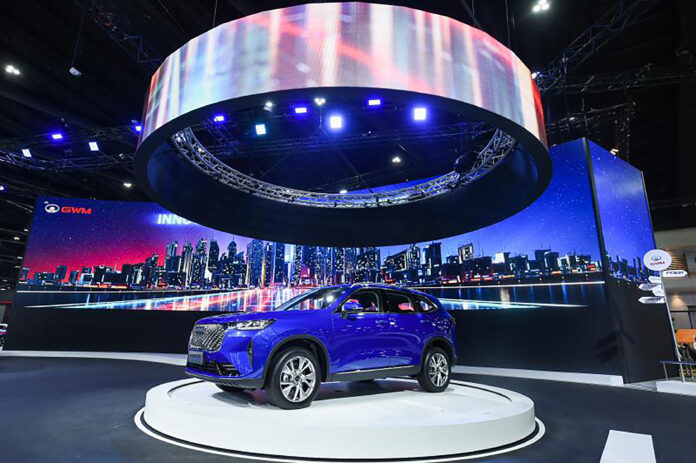Pakistan is not exactly car heaven. For a country of 200 million, there are only between 17 to 20 cars per 1000 people (as per 2018 data). Also, the kind of cars we have are limited as well The average Pakistani household has 6.7 people. Yet our preferred method of transportation is the classic, stuff everyone in the tiny car, philosophy. Barring that, it has been a ‘van’ – think the Suzuki Bolan, or APV, that is useful for larger families. For families that own cars, sedans are the done deal. And those sedans tend to be Japanese. Suzuki might as well be Pakistani, for its brand recognition in the country.
We paint this picture for you to understand why Profit considers Sazgar such an anomaly. The automobile assembler has decided to introduce SUVs from China in the Pakistani market. Will it work?
First, who are Sazgar? The company is principally engaged in the manufacturing and sale of three wheelers including auto rickshaws, tractor wheel rims and home appliances during the financial year. It has done mostly well: if one looks at the last six years of financials, turnover has risen from Rs2.5 billion in 2015, to Rs 3.9 billion in 2018, to Rs2.8 billion in 2020. Similarly, net income from Rs74 million in 2015, to Rs186 million in 2018, to Rs27 million in 2020.
Which leads to the question: what happened in 2020? That year is very much an anomaly: according to the company’s annual report, economic slowdown, higher inflation rate and higher borrowing cost deeply affected the automobile industry. In fact, during 2020, there was a decline in production and sale in respect of cars 54.90% and 53.50%, tractors 34.70% and 35.10%, 2&3 wheelers 23.10% and 23.10% respectively.
Plus, Sazgar shut its operations for an entire month during 2020, thereby missing its own production and sale targets. Consider: the net sale of three wheelers decreased from Rs 2,697.04 million to Rs 2,404.97 million, reflecting a decline of 10.83%. The net sale of automotive parts declined by 4.84 % from Rs 500.20 million to Rs 476.00 million. The net sales of home appliances has decreased from Rs 9.38 million to Rss 4.41 million compared with the corresponding period of last year.
But both Sazgar (and by extension, this magazine), are hopeful about the future. As the annual report notes: “The Company intends to introduce passenger cars and off-road vehicles in the market during the financial year 2020-21. This would be the new segment of market for the Company and it has to face various challenges for penetration in the market. The Company is establishing a solid dealership network throughout the country for the marketing, sale and after sale service of its products. The Company is receiving inquiries on daily basis from the prospective buyers of the passenger cars and off-road vehicles and interested parties for the dealership”.
So to the first trend: SUVs. The trend of SUVS has been slow to catch on in Pakistan – they are expensive, they consume a lot of fuel, and in previous years, the road conditions did not warrant such nice cars. But this has changed in the last few years: SUVs are now the rage for that group of people who would typically have opted for a high-end sedan. SUVs account for less than 10% of all car sales in Pakistan, but are expected to grow (consider India, where SUV car sales now account for 36%). Those that would have bought nice Honda Civics and Toyota Corollas are now gravitating towards compact SUVs.
Sazgar is hoping to bank on this market. It has already introduced BAIC, or Beijing Automotive Industry Holding Co., Ltd.
BAIC is huge: it is a Chinese state-owned enterprise that has existed for 59 years, and is now the third largest automotive group in China, producing more than two million vehicles a year with 2.4 million sold units in 2018. It also exports to more than 40 countries or regions. Crucially, the company is the third largest electric vehicle manufacturer in the world.
Now, Sazgar, in a notice to the PSX on March 18, has said that it will introduce another Chinese brand, Haval. This is an SUV brand of another Chinese automaker, Great Wall Motors. The company has only been around since 2002, and created a name for itself by introducing the SUV craze in China in the mid-2000s.
Both BAIC and GWM have massive operations within China, slick English websites (key for Chinese firms), and a sizable global presence. Yet there is one country that seems to have missed the boat: Pakistan. It is perhaps a testament to Pakistan’s automobile ‘backwardness’ that our only conceptions of cars still seem very much stuck to dated Japanese models.
Even Sazgar is aware of this. As it notes: “This brand is much famous in the Chinese markets and BAIC group is one of the largest vehicle manufacturers in China specially the Off- Road vehicles. The products are already trial and tested in China. However, the brand is new for the Pakistani markets.”
The company says it has started “ abrand awareness campaign on social media which is being proved very effective. Alongside, the company has also imported some units of these vehicles which are being tested on Pakistani Roads under local weather conditions. The results so far are encouraging.”
Will it be enough to make Pakistanis switch?


























Please lunch baic x25